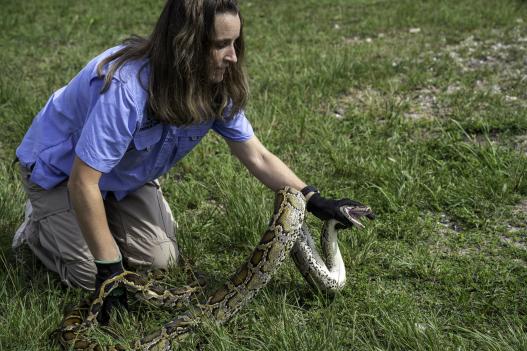August 2023 Edition | Volume 77, Issue 8
Published since 1946
The Florida Python Challenge and Beyond: Addressing Invasive Species in the Southeast
Florida's diverse ecosystems are home for countless species of plants and animals. However, both the intentional and unintentional introduction of non-native invasive species has created an unprecedented challenge to these inhabitants and their habitats. Among these, the Burmese python stands out due to its rapid population explosion and harmful ecological impact. To confront this menace, the Florida Fish and Wildlife Conservation Commission (FWC) instituted the "Florida Python Challenge,” a community-driven initiative aimed at curbing the python population. Since its inception in 2013, this Challenge has garnered significant success, with participants removing more than 18,000 snakes, many of which were also carrying dozens of eggs. This effort has set the stage for similar initiatives against other invasive species, not just in Florida, but across the Southeast.

The Challenge
Originating from Southeast Asia, Burmese pythons were introduced to Florida largely through the pet trade. Their release or escape into the wild, is thought to be the result of the devastation caused by hurricane Andrew in 1992, which allowed untold privately-owned animals as well as those for sale in pet stores to escape. This led to an unchecked expansion of pythons in the Everglades, which was exacerbated by the absence of natural predators for these large reptiles. Over the past several decades, these invaders have wreaked havoc on native species, from birds to mammals, including deer, pigs, alligators, and other fauna, thus potentially disrupting food chains and overall ecosystem balance.
The Florida Python Challenge, conducted by the FWC in collaboration with entities such as the South Florida Water Management District, has been pivotal in engaging the public in the removal of these reptiles. Beyond mere removal, it has been a platform for educating the public about the fragile ecosystems of the Everglades and the repercussions of introducing non-native species. As the Challenge reaches its 10-year anniversary, it has facilitated the removal of many thousands of pythons, restoring some balance and affording native fauna a fighting chance. Its dual-pronged approach of eradication and education serves as a blueprint for addressing other invasive threats.
Other Invasive Offenders in the Southeast
Florida and the broader Southeast region are no strangers to invasive species. Apart from the python, this southeastern state is home to many other notable invaders:
- Lionfish: Native to the Indo-Pacific, lionfish were introduced to Florida waters in the 1980s. Their ravenous appetite and rapid reproduction rates have led to the decline of native fish species and have upset coral reef ecosystems.
- Cuban Tree Frog: Originating in the Caribbean, these frogs have a voracious appetite and consume many native species, causing declines in native frog populations and also preying on smaller native fauna.
- Tegu Lizards: These South American reptiles have established populations in Florida. They are omnivorous, feeding on a variety of animals and eggs, posing a threat to native species.
- Cogongrass: Spreading across the Southeast, this invasive grass outcompetes native plants, reducing biodiversity and increasing fire risks due to its flammability.
- Water Hyacinth: A floating plant native to the Amazon Basin, it has become a menace in many of Florida's waterways, crowding out native species, reducing oxygen levels, and impacting aquatic life.
The Road Ahead
The lessons from the Florida Python Challenge extend beyond pythons. Invasive species, irrespective of their origin, pose a common threat – the degradation of native ecosystems. Florida's proactive approach in rallying community support, fostering education, and initiating eradication programs sets an example for the rest of the Southeast and indeed the world.
As the Southeast grapples with its invasive species, it's paramount to remember that proactive measures, research, community involvement, and education are the cornerstones of conservation. The success stories, challenges, and ongoing efforts in this region offer a comprehensive playbook for other areas confronting the menace of invasive species.